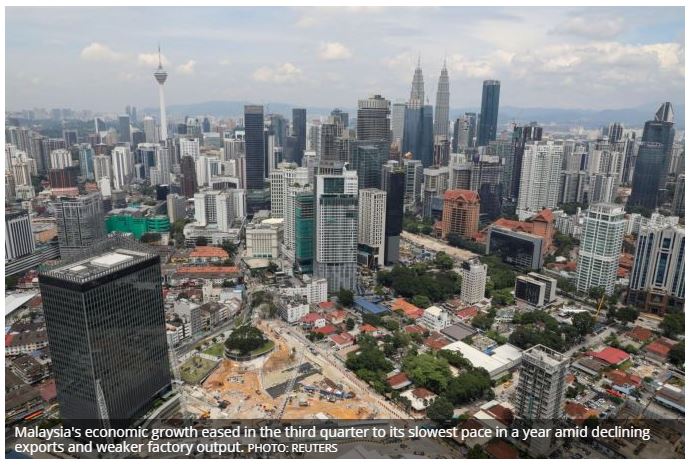Malaysia economy grows 4.4 % in Q3, slowest pace in a year amid global slowdown
MALAYSIA’S economic growth eased in the third quarter to its slowest pace in a year amid declining exports and weaker factory output.
Gross domestic product (GDP) rose 4.4 per cent in the three months till September from a year ago, according to figures from the central bank. That matched the median expectation in a Bloomberg survey of economists.
The slower third-quarter print comes after Malaysia’s economy bucked the regional trend in the previous three months by expanding 4.9 per cent – its fastest pace in more than a year – even as its neighbours’ growth slowed.
Analysts are calling for Malaysia’s central bank to begin easing borrowing costs next year after a surprise cut last week to banks’ reserve ratio requirement hinted at the need to bolster growth.
“The weak growth figure in every sector means BNM (Bank Negara Malaysia) will need to cut rates to support growth,” said Trinh Nguyen, senior economist at Natixis Asia in Hong Kong, predicting the benchmark rate will be 50 basis points lower by the end of 2020. Inflation “is low and growth is decelerating, so the hurdles to a rate cut are low”.
Signs of strain have begun to show in Malaysia’s economy as exports slid in September by the most since 2016 and industrial production growth eased in the three months till September. The global downturn has put pressure on Prime Minister Mahathir Mohamad’s government, which widened its 2020 budget deficit target to support growth, delaying its goal of fiscal consolidation.
In slides accompanying the data release, Bank Negara Malaysia said the economy will remain “resilient” this year and next, and that monetary policy “remains accommodative and supportive of economic activity”.
The central bank is maintaining its full-year forecast of 4.3 to 4.8 per cent GDP growth for 2019, governor Nor Shamsiah Mohd Yunus told reporters.
“We think the economy is likely to lose more steam in the quarters ahead,” Alex Holmes, an economist with Capital Economics, wrote in a research note. “Looser monetary policy is likely to be offset by headwinds from elsewhere. Tighter fiscal policy is a key headwind as the government aims to bring down the budget deficit.”
Khoon Goh, head of Asia research at Australia & New Zealand Banking Group in Singapore, said Friday’s data was neutral for the ringgit. The currency held its gains after the release, up 0.2 per cent to 4.1483 per US dollar.
The reserve-ratio cut earlier this month, coupled with signs that activity may be starting to recover, “suggest that there is no urgency” for the central bank to cut its benchmark rate, he said.
Data on Friday showed annual growth in GDP components slowed almost across the board compared to the second quarter. Domestic demand and a resumption of big-ticket transport projects will help support the economy going forward, while risks include the trade war and commodity-price volatility, the central bank said.
Despite the overall decline in exports as global growth slows, US-China trade tensions have allowed Malaysia to ship an additional US$1.4 billion of goods to the world’s two largest economies from January to August, the central bank said.
Asked if the reserve-ratio cut was a prelude to further adjustments to the benchmark rate, Mr Shamsiah said the central bank is “not on a preset” course and will monitor incoming data. The central bank has cut rates once this year by 25 basis points, less than the easing carried out by many of its South-east Asian peers. BLOOMBERG
Source: https://www.businesstimes.com.sg/government-economy/malaysia-economy-grows-44-in-q3-slowest-pace-in-a-year-amid-global-slowdown


 English
English




